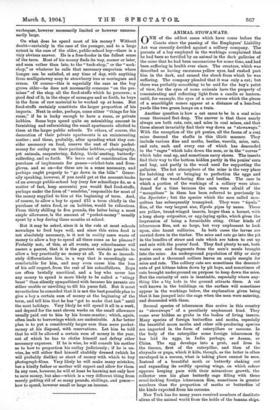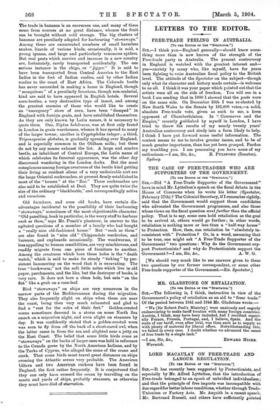ANIMAL STOWAWAYS.
ONE of the oddest cases which have come before the Courts since the passing of the Employers' Liability
Act was recently decided against a colliery company. The parents of a boy employed in the workings complained that he had been so terrified by an animal in the dark galleries of the mine that he had been unconscious for some time, and had been suffering in health ever since. The creature, which was described as having enormous yellow eyes, had rushed past him in the dark, and caused the shock from which he was suffering. The company pleaded that it was only a cat; but there was probably something to be said for the boy's point of view, for the eyes of some animals have the property of concentrating and reflecting light from a candle or lantern, until, for example, the eyes of a cow across which the gleam of a searchlight comes appear at a distance of a hundred yards like two green lamps on a train.
Another question is how a cat came to be in a coal mine some thousand feet deep. The answer is that there nearly always are both cats, rats, and mice in coal mines, and that these almost invariably find their way down as "stowaways." With the exception of the pit ponies, all the fauna of a coal mine descend the shafts in this illicit manner. They include various flies and moths, beetles, weevils, mice, rats, and cats, each and every one of which has descended in the "cages " which take down the men, or in the" cot-yes" which take coal up, and sometimes carry stores. The insects find their way to the bottom hidden partly in the ponies' corn and hay, and partly in the wood used for supporting the galleries. The hot atmosphere of the mine is the very place for hatching out or bringing to perfection the eggs and larvae of the wood-boring flies and beetles. The case in which a portion of the workings of a colliery were aban- doned for a time because the men were afraid of the "mosquitoes" in them has been referred to previously in the Spectator ; but the species which the men called mos- quitoes has subsequently transpired. They were " tipula " flies, of the very largest size, Tipula gigas by name. These are yellow, broad-winged insects, larger than a hornet, with a long sharp ovipositor, or egg-laying spike, which gives the impression of being a formidable sting. Other kinds of ichneumon flies, not so large, but very unpleasant to look upon, also haunt collieries. In both cases the larvae are carried down in the timber. The mice and rats go into the pit in the bundles of straw and oats which are taken to cut up and mix with the ponies' food. They find plenty to eat, both waste corn and fragments from the men's meals brought into the mine. An underground population of fifty or sixty ponies and a thousand colliers leaves an ample margin for mice and rats. The colliery cats are sometimes the descend- ants of pet kittens taken down by pit boys, and sometimes of cats brought underground on purpose to keep down the mice. But the curiosity of cats is insatiable, especially where any- thing like a big hole in the ground attracts them. A cat well known in the buildings on the surface will sometimes appear in the workings below, the explanation given being that it has jumped into the cage when the men were entering, and descended with them.
Several species of ichneumon flies arrive in this country
as "stowaways" of a peculiarly unpleasant kind. They come over hidden as grubs in the bodies of living insects. Many species of foreign butterflies and moths, especially the beautiful moon moths and other silk-producing species are imported in the form of caterpillars or cocoons. In the body of the caterpillar some foreign ichneumon fly has laid its eggs, in India perhaps, or Assam, or China. The egg develops into a grub, and lives in the tissues, first of the caterpillar, and then of the chrysalis or pupa, which it kills, though, as the latter is often enveloped in a cocoon, what is taking place cannot be seen. Instead of a beautiful moth or butterfly shaking out and expanding its swiftly opening wings, on which colour appears keeping pace with their miraculous growth, the collector sees his glass butterfly cage filling with these cruel-looking foreign ichneumon flies, sometimes in greater numbers than the proportion of moths or butterflies of the kinds expected from his cocoons.
New York has for many years received numbers of destitute aliens of the animal world from the holds of the banana ships. The trade in bananas is an enormous one, and many of them come from sources at no great distance, whence the fruit can be brought without cold storage. The big clusters of bananas are peculiarly adapted for harbouring "stowaways." Among these are enumerated numbers of small harmless snakes, lizards of various kinds, occasionally, it is said, a young iguana, and large and particularly venomous spiders. But real pests which survive and increase in a new country are, fortunately, rarely transported accidentally. The one serious instance is the chigo, or "jigger." It is said to have been transported from Central America to the East Indies in the feet of Indian coolies, and by other Indian coolies to the coast of East Africa. The Colorado beetle has never succeeded in making a home in England, though " mosquitoes " of a peculiarly ferocious, though non-malarial, kind are said to have appeared in English hotels. Several corn-beetles, a very destructive type of insect, and among the greatest enemies of those who would like to create an "emergency" store of corn, have been " dumped " in England with foreign grain, and have established themselves. As they are only known by Latin names, it is necessary to quote them, One, Niptus hololeucus, was at first only found in London in grain warehouses, whence it has spread to many of the larger towns; another is Oryptophilus integer; a third, Trigonogenius globulus, is gradually spreading over England, and is especially common in the Oldham mills; but these do not by any means exhaust the list. A large and sombre beetle, an inhabitant of Central Europe, the Latin name of which celebrates its funereal appearance, was the other day discovered wandering in the London docks. But the most conspicuous among foreign creatures of the beetle kind getting their living as resident aliens of a very undesirable sort are the large Oriental cockroaches, at present firmly established in most of the " houses " at the "Zoo." These cockroaches are also said to be established at Deal. They are quite twice the size of the ordinary " blackbeetle," and correspondingly active and voracious.
Old furniture, and even old books, have certain dis- advantages incidental to the possibility of their harbouring "stowaways," sometimes of the most objectionable character. "Old panelling, honk in particular, is the welly stuff to harbour such as them," says Mr. Punch's plasterer, in answer to the agitated questions of a member of a family who had bought a "really nice old-fashioned house." But "such as them" are also found in "nice old" Chippendale wardrobes, and bureaux, and cupboards occasionally. The woodworms, if less appalling to human sensibilities, are very mischievous, and readily migrate from one piece of furniture to another. Among the creatures which bore these holes is the "death watch," which is said to make its steady " ticking " by per- sistent hammering on the wood that it is excavating. The true "bookworm," not the soft little mites which live in old paper, parchments, and the like, but the destroyer of books, is very rare. It does not bore a clean hole, but eats "on the flat" like a grub on a rose-leaf.
Bird "stowaways" on ships are very numerous in the narrow parts of the Mediterranean during the migration. They also frequently alight on ships when these are near the coast, being then very much exhausted and glad to find a "rest for the soles of their feet." Golden-crested wrens sometimes descend in a storm on some North Sea smack on a migration night, and even alight on steamers by day. It was confidently stated that a golden-crested wren was seen to fly from off the back of a short-eared owl, when the latter came in from the sea and alighted near a jettyan the East Coast. The belief that some little birds come as " stowaways " on the backs of larger ones was held in reference to the Canada geese by the North American Indians, and by the Turks of Cyprus, who alleged the same of the crane and stork. That some birds must travel great distances on ships crossing the Atlantic seems very probable. The American bittern and two American cuckoos have been found in England, the first rather frequently. It is conjectured that they can only have crossed the ocean by travelling on the masts and yards of ships, probably steamers, as otherwise they must have died of starvation.











































 Previous page
Previous page